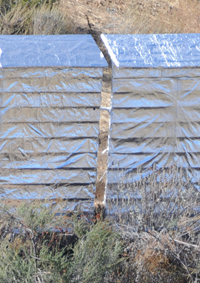“The right material can save a house and protect homeowners and firefighters, too. It would be safer and more environmentally friendly than traditional measures.”
Engineers Seek Protective Cover
Research Professor Fumiaki Takahashi and partners look to save houses and lives with fire blankets
 If this were a classified ad, it would read something like this:
If this were a classified ad, it would read something like this:
- Ambitious engineer seeks tough material that will put itself in harm's way to protect others in case of emergency. Must be flexible, durable and not too heavy.
- If interested, please call Fumiaki Takahashi, PhD, Case School of Engineering.
- Those who can't take the heat need not apply.
Takahashi, his colleague James S. T'ien and collaborators from NASA have already gotten leads on more than 40 fabrics they thought were up to the test. But the researchers are still keeping their options open.
There's good reason to be picky. After all, in the event of a wildfire, it will be up to the chosen material to unroll from the roof of a house, spread over the home's outside walls and shield families and their possessions from danger.
"The right material can save a house and protect homeowners and firefighters, too," Takahashi says. "It would be safer and more environmentally friendly than traditional measures."
The team has already tested woven fiberglass, amorphous silica, pre-oxidized carbon and aramid-based fiber—which is used in firefighters' protective uniforms—among other potential candidates. Aluminized materials seem to be the frontrunners thus far, but concerns remain about weight: One such material was only 1 millimeter thick, but a 1,000-square-foot blanket made of it weighed more than 150 pounds, making it too cumbersome a cover.
The chosen material will be put to work in the western states, where every summer, fires rage in the so-called wildland-urban interface—the perilous border between forests and towns. And there will likely be plenty of work to go around, as government estimates show that 38 percent of new houses in the West are in these potentially dangerous zones.
"The fire blanket can save homes. It can make firefighters' jobs easier, and it can reduce loss of lives and property," Takahashi says.
See more of the picture: See pictures of fire blanket experiments and watch a video.

